Seed Transmission of Tomato Leaf Curl New Delhi Virus from Zucchini Squash in Italy
Abstract
1. Introduction
2. Results and Discussion
2.1. ToLCNDV Infection in Zucchini Squash Plants
2.2. ToLCNDV Infection of Naturally Germinated Young Seedlings
2.3. ToLCNDV Contamination of Zucchini Squash Seeds
2.4. ToLCNDV Dissemination of Zucchini Squash Seedlings Germinated from Infected Seeds
2.5. Mechanical Inoculation of Seed-Borne ToLCNDV
3. Materials and Methods
3.1. Seeds Collection and Preparation
3.2. DNA Extraction and PCR Analysis for ToLCNDV Detection
3.3. Mechanical Inoculation
Author Contributions
Funding
Conflicts of Interest
References
- Moriones, E.; Praveen, S.; Chakraborty, S. Tomato Leaf Curl New Delhi Virus: An Emerging Virus Complex Threatening Vegetable and Fiber Crops. Viruses 2017, 9, 264. [Google Scholar] [CrossRef] [PubMed]
- Zaidi, S.S.E.A.; Martin, D.P.; Amin, I.; Farooq, M.; Mansoor, S. Tomato leaf curl New Delhi virus: A widespread bipartite begomovirus in the territory of monopartite begomoviruses. Mol. Plant Pathol. 2017, 18, 901–911. [Google Scholar] [CrossRef]
- Vasudeva, R.; Sam, R. A leaf-curl disease of tomato. Phytopathology 1948, 38, 364–369. [Google Scholar]
- Padidam, M.; Beachy, R.N.; Fauquet, C.M. Tomato leaf curl geminivirus from India has a bipartite genome and coat protein is not essential for infectivity. J. Gen. Virol. 1995, 76, 25–35. [Google Scholar] [CrossRef]
- Hussain, M.; Mansoor, S.; Iram, S.; Zafar, Y.; Briddon, R. First report of Tomato leaf curl New Delhi virus affecting chilli pepper in Pakistan. Plant Pathol. 2004, 53, 794. [Google Scholar] [CrossRef]
- Mizutani, T.; Daryono, B.; Ikegami, M.; Natsuaki, K. First report of Tomato leaf curl New Delhi virus infecting cucumber in Central Java, Indonesia. Plant Dis. 2011, 95, 1485. [Google Scholar] [CrossRef]
- Chang, H.-H.; Ku, H.-M.; Tsai, W.-S.; Chien, R.-C.; Jan, F.-J. Identification and characterization of a mechanical transmissible begomovirus causing leaf curl on oriental melon. Eur. J. Plant Pathol. 2010, 127, 219–228. [Google Scholar] [CrossRef]
- Maruthi, M.; Rekha, A.; Cork, A.; Colvin, J.; Alam, S.; Kader, K. First report of Tomato leaf curl New Delhi virus infecting tomato in Bangladesh. Plant Dis. 2005, 89, 1011. [Google Scholar] [CrossRef]
- Ito, T.; Sharma, P.; Kittipakorn, K.; Ikegami, M. Complete nucleotide sequence of a new isolate of tomato leaf curl New Delhi virus infecting cucumber, bottle gourd and muskmelon in Thailand. Arch. Virol. 2008, 153, 611–613. [Google Scholar] [CrossRef]
- Tahir, M.; Haider, M. First report of Tomato leaf curl New Delhi virus infecting bitter gourd in Pakistan. Plant Pathol. 2005, 54, 807. [Google Scholar] [CrossRef]
- Yazdani-Khameneh, S.; Aboutorabi, S.; Shoori, M.; Aghazadeh, A.; Jahanshahi, P.; Golnaraghi, A.; Maleki, M. Natural occurrence of tomato leaf curl New Delhi virus in Iranian cucurbit crops. Plant Pathol. J. 2016, 32, 201. [Google Scholar] [CrossRef] [PubMed]
- Kirthi, N.; Maiya, S.; Murthy, M.; Savithri, H. Evidence for recombination among the tomato leaf curl virus strains/species from Bangalore, India. Arch. Virol. 2002, 147, 255–272. [Google Scholar] [CrossRef] [PubMed]
- Chatchawankanphanich, O.; Maxwell, D.P. Tomato leaf curl Karnataka virus from Bangalore, India, appears to be a recombinant begomovirus. J. Phytopathol. 2002, 92, 637–645. [Google Scholar] [CrossRef]
- Fortes, I.; Sánchez-Campos, S.; Fiallo-Olivé, E.; Díaz-Pendón, J.; Navas-Castillo, J.; Moriones, E. A novel strain of tomato leaf curl New Delhi virus has spread to the Mediterranean basin. Viruses 2016, 8, 307. [Google Scholar] [CrossRef]
- Juárez, M.; Tovar, R.; Fiallo-Olivé, E.; Aranda, M.; Gosálvez, B.; Castillo, P.; Moriones, E.; Navas-Castillo, J. First detection of Tomato leaf curl New Delhi virus infecting zucchini in Spain. Plant Dis. 2014, 98, 857. [Google Scholar] [CrossRef]
- Parrella, G.; Troiano, E.; Formisano, G.; Accotto, G.P.; Giorgini, M. First Report of Tomato leaf curl New Delhi Virus Associated with Severe Mosaic of Pumpkin in Italy. Plant Dis. 2018, 102, 459. [Google Scholar] [CrossRef]
- Panno, S.; Iacono, G.; Davino, M.; Marchione, S.; Zappardo, V.; Bella, P.; Tomassoli, L.; Accotto, G.; Davino, S. First report of Tomato leaf curl New Delhi virus affecting zucchini squash in an important horticultural area of southern Italy. New Dis. Rep. 2016, 33, 2044-0588.2016. [Google Scholar] [CrossRef]
- Mnari-Hattab, M.; Zammouri, S.; Belkadhi, M.; Doña, D.B.; Ben Nahia, E.; Hajlaoui, M. First report of Tomato leaf curl New Delhi virus infecting cucurbits in Tunisia. New Dis. Rep. 2015, 31, 2044-0588.2015. [Google Scholar] [CrossRef]
- Panno, S.; Caruso, A.; Troiano, E.; Luigi, M.; Manglli, A.; Vatrano, T.; Iacono, G.; Marchione, S.; Bertin, S.; Tomassoli, L.; et al. Emergence of tomato leaf curl New Delhi virus in Italy: Estimation of incidence and genetic diversity. Plant Pathol. 2019, 68, 601–608. [Google Scholar] [CrossRef]
- Gallet, R.; Michalakis, Y.; Blanc, S. Vector-transmission of plant viruses and constraints imposed by virus–vector interactions. Curr. Opin. Virol. 2018, 33, 144–150. [Google Scholar] [CrossRef]
- Fabre, F.; Moury, B.; Johansen, E.I.; Simon, V.; Jacquemond, M.; Senoussi, R. Narrow bottlenecks affect pea seedborne mosaic virus populations during vertical seed transmission but not during leaf colonization. PLoS Pathog. 2014, 10, e1003833. [Google Scholar] [CrossRef]
- Stanley, J.; Boulton, M.I.; Davies, J.W. Geminiviridae. eLS 2001. [Google Scholar] [CrossRef]
- Kil, E.-J.; Kim, S.; Lee, Y.-J.; Byun, H.-S.; Park, J.; Seo, H.; Kim, C.-S.; Shim, J.-K.; Lee, J.-H.; Kim, J.-K.; et al. Tomato yellow leaf curl virus (TYLCV-IL): A seed-transmissible geminivirus in tomatoes. Sci. Rep. 2016, 6, 19013. [Google Scholar] [CrossRef] [PubMed]
- Kil, E.-J.; Park, J.; Choi, E.-Y.; Byun, H.-S.; Lee, K.-Y.; An, C.G.; Lee, J.-H.; Lee, G.-S.; Choi, H.-S.; Kim, C.-S.; et al. Seed transmission of Tomato yellow leaf curl virus in sweet pepper (Capsicum annuum). Eur. J. Plant Pathol. 2018, 150, 759–764. [Google Scholar] [CrossRef]
- Kil, E.-J.; Park, J.; Choi, H.-S.; Kim, C.-S.; Lee, S. Seed transmission of Tomato yellow leaf curl virus in white soybean (Glycine max). Plant Pathol. J. 2017, 33, 424–428. [Google Scholar] [CrossRef] [PubMed]
- Kim, J.; Kil, E.J.; Kim, S.; Seo, H.; Byun, H.S.; Park, J.; Chung, M.N.; Kwak, H.R.; Kim, M.K.; Kim, C.S.; et al. Seed transmission of Sweet potato leaf curl virus in sweet potato (Ipomoea batatas). Plant Pathol. 2015, 64, 1284–1291. [Google Scholar] [CrossRef]
- Kothandaraman, S.V.; Devadason, A.; Ganesan, M.V. Seed-borne nature of a begomovirus, Mung bean yellow mosaic virus in black gram. Appl. Microbiol. Biotechnol. 2016, 100, 1925–1933. [Google Scholar] [CrossRef]
- Manivannan, K.; Renukadevi, P.; Malathi, V.G.; Karthikeyan, G.; Balakrishnan, N. A new seed-transmissible begomovirus in bitter gourd (Momordica charantia L.). Microb. Pathog. 2019, 128, 82–89. [Google Scholar] [CrossRef]
- Suruthi, V.; Nakkeeran, S.; Renukadevi, P.; Malathi, V.; Rajasree, V. Evidence of seed transmission of dolichos yellow mosaic virus, a begomovirus infecting lablab-bean in India. VirusDisease 2018, 29, 506–512. [Google Scholar] [CrossRef]
- Sangeetha, B.; Malathi, V.; Alice, D.; Suganthy, M.; Renukadevi, P. A distinct seed-transmissible strain of tomato leaf curl New Delhi virus infecting Chayote in India. Virus Res. 2018, 258, 81–91. [Google Scholar] [CrossRef] [PubMed]
- Usharani, K.; Surendranath, B.; Paul-Khurana, S.; Garg, I.; Malathi, V. Potato leaf curl–a new disease of potato in northern India caused by a strain of tomato leaf curl New Delhi virus. Plant Pathol. 2004, 53, 235. [Google Scholar] [CrossRef]
- López, C.; Ferriol, M.; Picó, M.B. Mechanical transmission of Tomato leaf curl New Delhi virus to cucurbit germplasm: Selection of tolerance sources in Cucumis melo. Euphytica 2015, 204, 679–691. [Google Scholar] [CrossRef]
- Figàs, M.; Alfaro-Fernández, A.; Font, M.; Borràs, D.; Casanova, C.; Hurtado, M.; Plazas, M.; Prohens, J.; Soler, S. Inoculation of cucumber, melon and zucchini varieties with Tomato leaf curl New Delhi virus and evaluation of infection using different detection methods. Ann. Appl. Biol. 2017, 170, 405–414. [Google Scholar] [CrossRef]
- Trolinder, N.L.; Goodin, J. Somatic embryogenesis in cotton (Gossypium) I. Effects of source of explant and hormone regime. Plant Cell Tissue Organ Cult. 1988, 12, 31–42. [Google Scholar] [CrossRef]
- Ye, J.; Coulouris, G.; Zaretskaya, I.; Cutcutache, I.; Rozen, S.; Madden, T.L. Primer-BLAST: A tool to design target-specific primers for polymerase chain reaction. BMC Bioinform. 2012, 13, 134. [Google Scholar] [CrossRef]
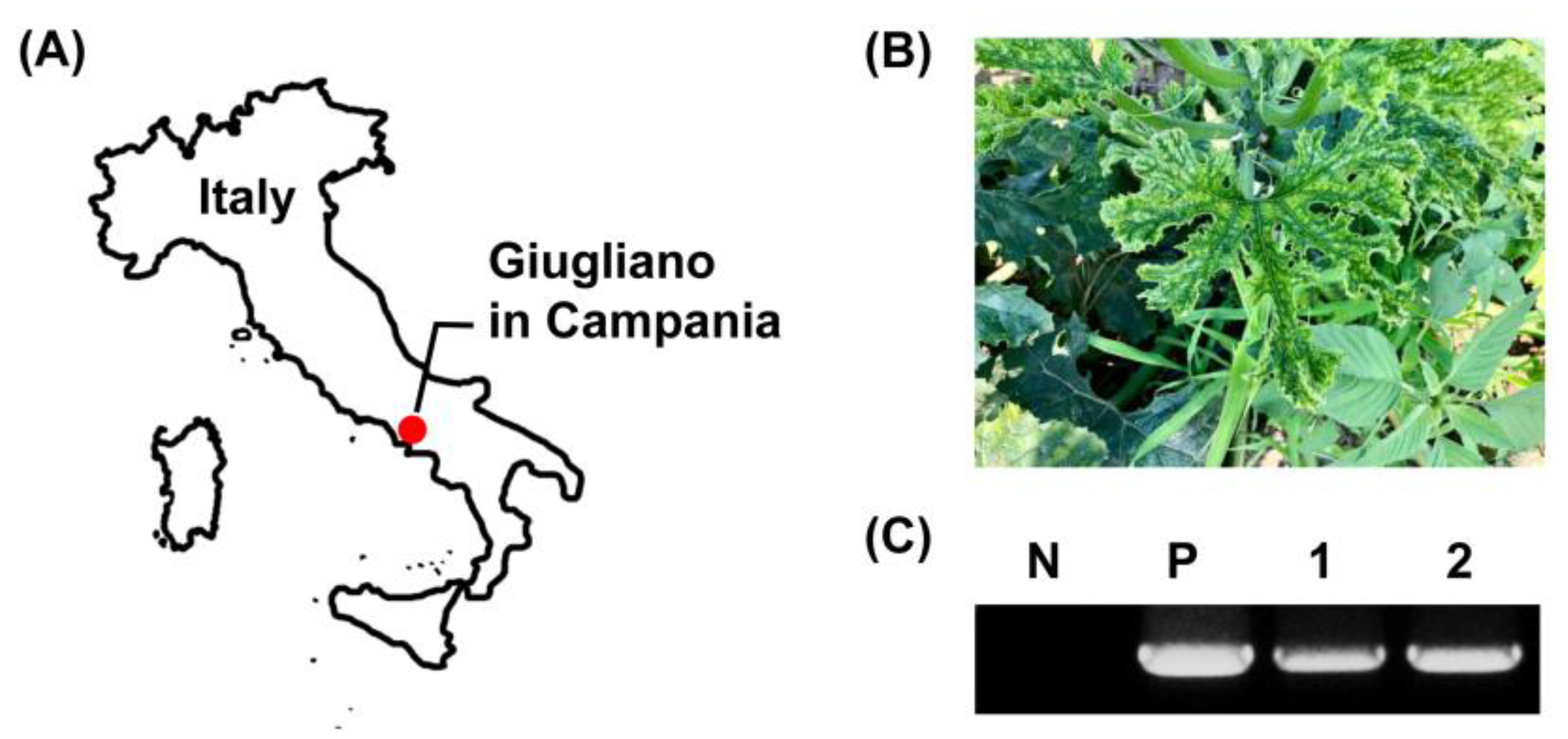
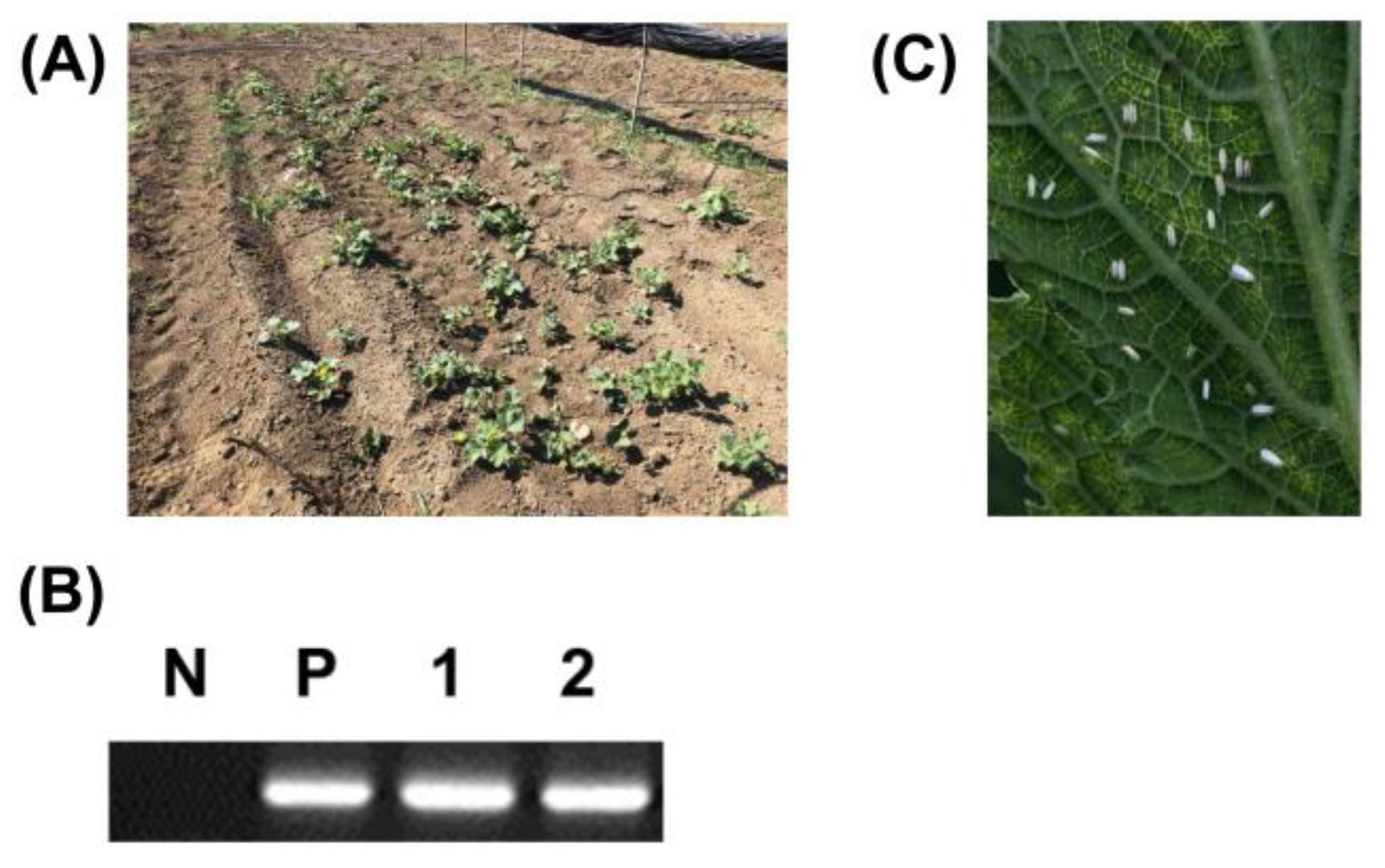
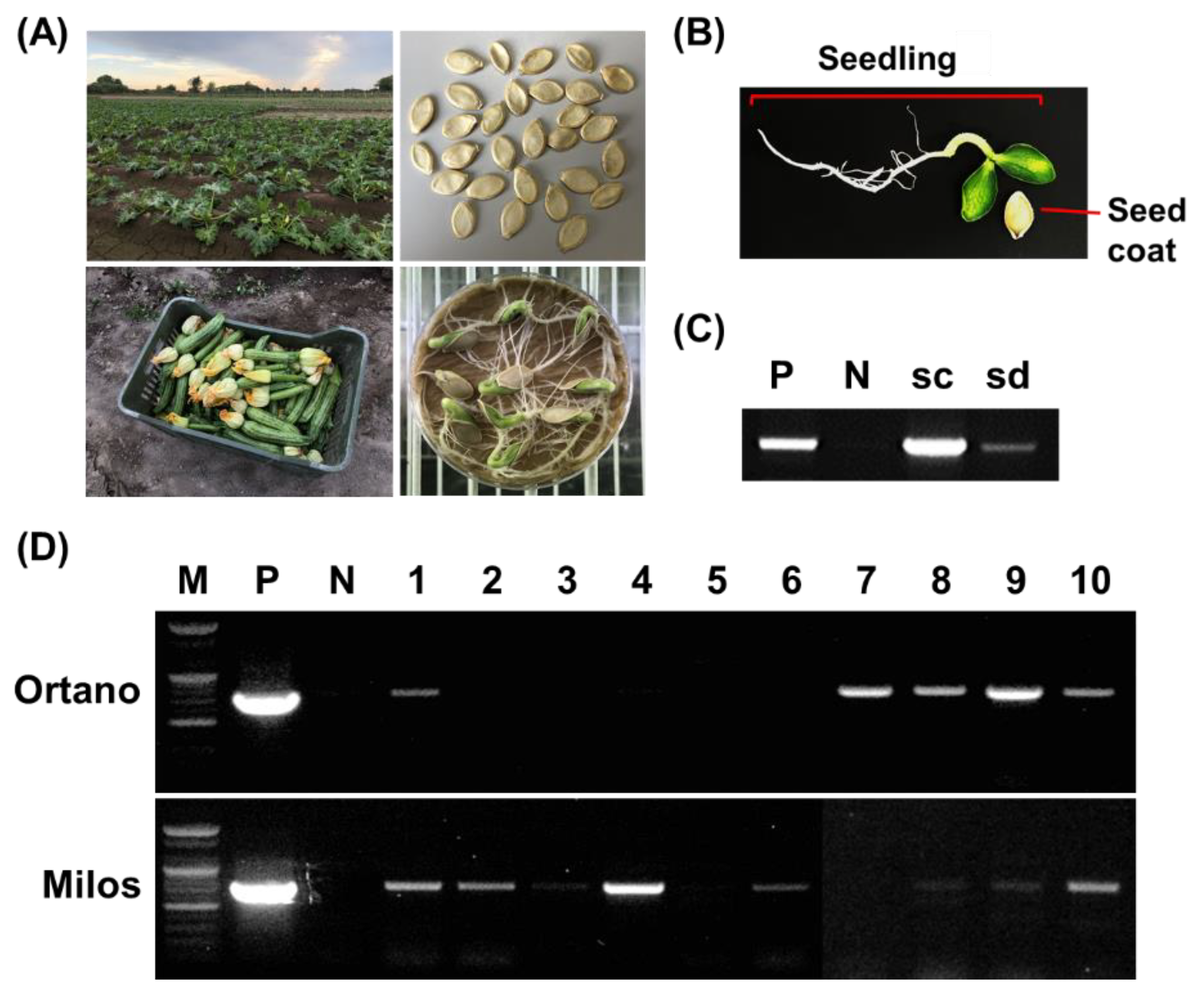
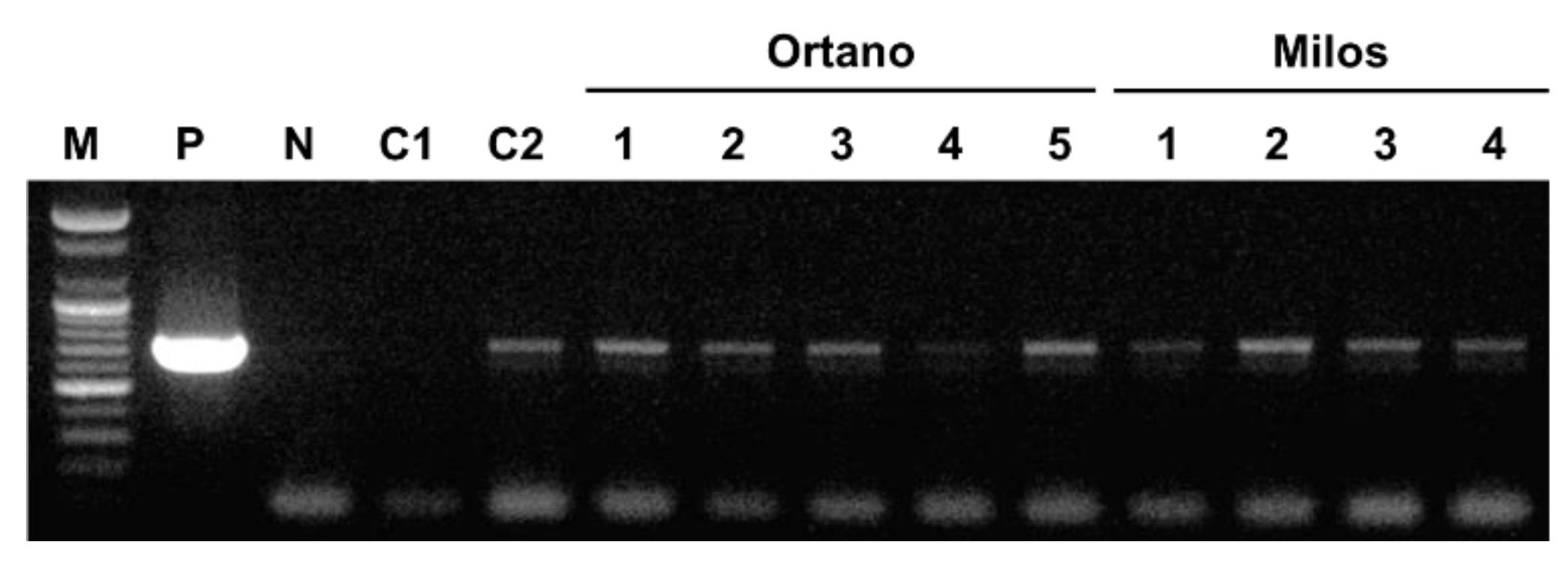
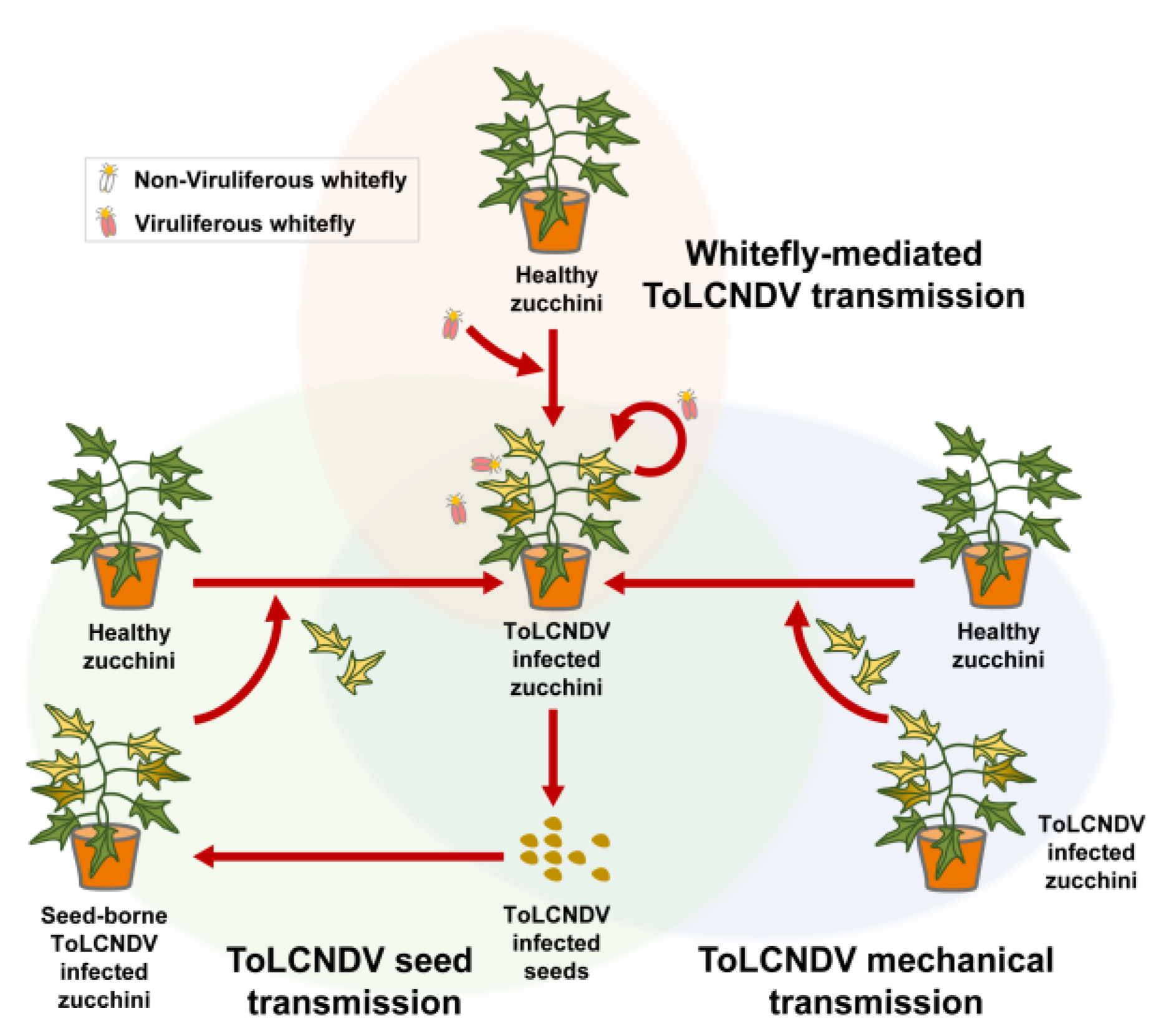
| Primer Name | Primer Sequence (5′—3′) | Target Size |
|---|---|---|
| ToLCNDV_DNA-A_F | GTG ATG TAC TCC CCT GTG CG | 738 bp |
| ToLCNDV_DNA-A_R | ACA AGA CAG ATG CGT TAA AGG TT |
| Plants (Cultivars) | Seed | Seedlings ** |
|---|---|---|
| Zucchini Squash cv. Milos | 30/30 (100) * | 16/28 (57.14) |
| Zucchini Squash cv. Ortano | 10/10 (100) | 11/16 (68.75) |
© 2020 by the authors. Licensee MDPI, Basel, Switzerland. This article is an open access article distributed under the terms and conditions of the Creative Commons Attribution (CC BY) license (http://creativecommons.org/licenses/by/4.0/).
Share and Cite
Kil, E.-J.; Vo, T.T.B.; Fadhila, C.; Ho, P.T.; Lal, A.; Troiano, E.; Parrella, G.; Lee, S. Seed Transmission of Tomato Leaf Curl New Delhi Virus from Zucchini Squash in Italy. Plants 2020, 9, 563. https://doi.org/10.3390/plants9050563
Kil E-J, Vo TTB, Fadhila C, Ho PT, Lal A, Troiano E, Parrella G, Lee S. Seed Transmission of Tomato Leaf Curl New Delhi Virus from Zucchini Squash in Italy. Plants. 2020; 9(5):563. https://doi.org/10.3390/plants9050563
Chicago/Turabian StyleKil, Eui-Joon, Thuy Thi Bich Vo, Chairina Fadhila, Phuong Thi Ho, Aamir Lal, Elisa Troiano, Giuseppe Parrella, and Sukchan Lee. 2020. "Seed Transmission of Tomato Leaf Curl New Delhi Virus from Zucchini Squash in Italy" Plants 9, no. 5: 563. https://doi.org/10.3390/plants9050563
APA StyleKil, E.-J., Vo, T. T. B., Fadhila, C., Ho, P. T., Lal, A., Troiano, E., Parrella, G., & Lee, S. (2020). Seed Transmission of Tomato Leaf Curl New Delhi Virus from Zucchini Squash in Italy. Plants, 9(5), 563. https://doi.org/10.3390/plants9050563





